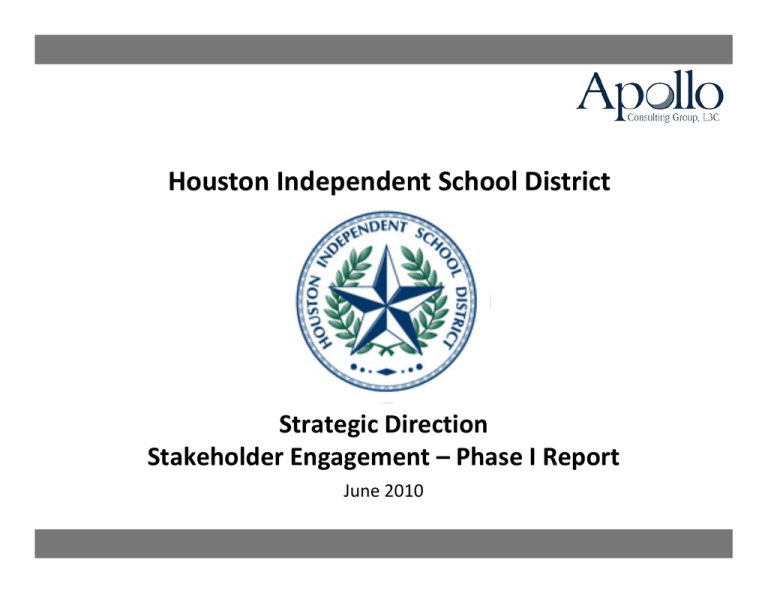Houston Independent School District Strategic Direction Stakeholder Engagement – Phase I Report June 2010
advertisement

Houston Independent School District Strategic Direction Stakeholder Engagement – Phase I Report June 2010 Stakeholder engagement is a key element of the strategic planning process Phase I Goals • Provide opportunities for a broad range of stakeholders to give input Timing February to May Board workshops March 4 April 29 Phase II • Paint the overall picture of transformation and gain feedback integrate in plan May to June May 20 June 17 Phase III • Disseminate the plan and mobilize support behind transformation July to August July 15 August 5 2 During Phase I, we gathered input from stakeholders through different channels Channel Reach •Strategic Direction Website with feedback capability •200+ comments posted received 9,400+ visits and 8,000+ unique views •17 Strategic Direction discussions held with key •~340 people attended stakeholder groups (e.g., students, parents, staff, •~100+ feedback cards philanthropic partners, nonprofit partners, business received community, broader community, etc) •Organizational survey sent to ~1,000 HISD staff •~350 responses •Community survey sent to 17,000+ people •780+ responses 3 Summary of findings from stakeholder engagement efforts in Phase I • Most stakeholders are not fully aware of HISD Declaration of Beliefs and Visions • The majority believe that the goals set by the Board of Education capture the priorities for HISD, but see a gap in execution • Stakeholders identified a number of strengths, with being a district of choice as number one • To achieve real transformation, stakeholders believe HISD needs to focus and prioritize its efforts • Stakeholders suggested specific actions they would like to see HISD take to reach its goals: –1 Increasing focus on hiring and supporting high‐quality teachers and principals –2 Enhancing instructional options to best prepare all students for college and career success –3 Integrating health, nutrition, physical activity, and support services into students’ education –4 Heightening safety measures at school campuses –5 Improving transparency and accountability –6 Augmenting frequency and clarity of communications –7 Providing further opportunities for parent engagement and creating partnerships with community, private sector, and government Input from stakeholders has informed the design of the core initiatives and strategies and will continue to be leveraged in developing implementation plans 4 Most stakeholders are not fully aware of HISD Declaration of Beliefs and Visions Level of awareness of HISD Declaration of Beliefs and Visions “I have seen and read the document but do not recall all of the content of the document” “Is it distributed at school events or on each school's Web site?” “The Declaration of Beliefs and Visions needs to be better communicated to the public” “I had to do a web search to find the declaration” N=788 Source: 2010 Strategic Direction community survey (English and Spanish results consolidated) 5 The majority agree with HISD goals and priorities but see a gap in execution Extent to which HISD goals capture the priorities for the district “I believe the goals outlined express what should be the goals for HISD. The trick is to actually implement these goals” “These goals are a great start” “The goals are ideal. I would like to see them be executed” “The words are great! Putting it all into action is the real challenge” N=777 Source: 2010 Strategic Direction community survey (English and Spanish results consolidated) 6 All goals set by the Board of Education are considered important to increasing student achievement Ranking of prioritization of district goals to increase student achievement (Rating average, based on scale of 1=lowest priority, 5=highest priority) “All of these goals are very important to help students achieve and ensure success in all district schools.” “All of the above objectives are essential to meet the desired goals” “All 5 goals are excellent. Priority of goals should be dictated by individual schools (e.g. some schools may need to focus on safety more than others) N=725 Source: 2010 Strategic Direction community survey (English and Spanish results consolidated) “All of these are high sounding goals, but I do not have enough data to give one goal a higher priority over another” 7 HISD is perceived to have several strengths, with being a district of choice as number one HISD key areas of strength “The main strength of HISD is its several strong magnet programs, especially in the arts. Possibly the last large urban district to offer such programs” “The Montessori option for all students” “My children's schools have had excellent teachers, staff and principals, but unfortunately I know that this is not the case for all HISD schools” “I like the large diversity of people and activities” N=775 Source: 2010 Strategic Direction community survey (English and Spanish results consolidated) 8 To achieve real transformation, HISD needs to focus and prioritize its efforts •“The district has a tendency to go after problems without solving the root causes.. It seems that we have new programs all the time, and none make a difference. HISD needs to focus its efforts on solving the most important issues” •“There are too many initiatives that aren’t pursued to completion” •“Too many projects and unnecessary assignments which keep us from the most important work” •“Too many priorities at one time that our messages get lost” •“The Board of Education needs to establish some prioritization regarding the different efforts that are needed to address the needs of the students in each region” 9 1 Increasing focus on hiring and supporting high-quality teachers and principals (1 of 2) Main themes Suggestions • Increased teacher motivation • “We need happier, more passionate teachers. At times it seems that teachers are just thrown into a classroom with us. They need better preparation“ • Teacher preparation and training that address current needs of students • “Teachers should be trained to teach 21st century skills. This goes beyond technology, it is knowing how to teach a different, more diverse student population that what we had in 1950’s. Teachers need to know how to support non‐English speakers and have classroom management skills” • “Teachers must be trained in how to support the whole child, not just academics” • “Teachers should be trained on how to be more demanding of their students from the beginning of the year” • “We need to train our teachers about how to treat children with different learning abilities” • “HISD should provide cultural diversity training to teachers” • “We need to recruit better math and science teachers” • Support to effective teachers • “HISD needs to provide more help for the strong innovative teachers” • “The district should demand a high standard for teachers and then support them” • “Focus on providing support for teachers” • Clear career pathways • “There should be clear guidelines for displaced teachers. I have eight years of experience, my position is being given up. I want to be an administrator but I do not know how” • “HISD should focus on having more upward mobility” Source: Phase I stakeholder input from multiple feedback channels 10 1 Increasing focus on hiring and supporting high-quality teachers and principals (2 of 2) Main themes Suggestions • Consistency in quality of principals •“It is important to have more consistency in the leadership of the schools. I recommend each principal and assistant principal be required to serve at least five years and be performing at the level required to the district before being promoted” •“A campus leader that supports the teachers is much in demand” •“HISD needs to hire and maintain quality principals, particularly at the middle and high school level” • Higher principal accountability •“HISD needs to hold principals to a higher standard” •“The district should select really strong, fair, and active principals. Give them goals and funding, and hold them accountable” Source: Phase I stakeholder input from multiple feedback channels 11 2 Enhancing instructional options to best prepare all students for college and career success (1 of 3) Main themes Suggestions • Increased consistency of school quality • “HISD needs to establish a minimum set of requirements for all HISD schools (building, technology, supplies, counselors). Some schools are unfairly funded, staffed, and maintained” • “HISD needs to ensure that the same practices are practiced throughout schools. I first attended Lamar High School and the curriculum was rigorous and then I transferred to Kashmere High School where the students are behind on their curriculum and moving at a slower pace. This is unacceptable“ • “The disparities among schools, particularly in low income areas is way too big. We have kids that are deprived of many basic resources, and yet they are expected to perform to the same standards than other peers who attend privileged schools such as T.H. Rogers. I hope that the elimination of regions will help ensure that all schools are equitable across the board” • “We need more Magnet/Vanguard opportunities for middle and high school, especially in the West area” • Increased academic rigor • “HISD needs to focus on content and academic rigor rather than test‐taking skills. With a rigorous curriculum, students will do well on tests. So please stop focusing teaching on teaching how to take a test” • “The bar is too low on academics. I have attended schools in other states and they are teaching students on a whole different level“ • “We need to align our educational process from elementary to high school to make sure there are no cracks to lose any student” • 21st century teaching methods • “English‐Spanish dual‐language instruction makes the most logical sense as it meets the criterion of preparing students for an increasingly global economy, and meets college language learning requirements more effectively than reliance upon traditional foreign language instruction. Further, a rapid expansion of dual‐language programs throughout HISD would not only serve to ‘level the playing field’ for Latino and Latino immigrant students, it might provide the stimulus for strengthening the Houston economy for decades to come by producing graduates equipped with a linguistic competitive edge” • “We need to fund technology projects for schools to prepare children for a great future” Source: Phase I stakeholder input from multiple feedback channels 12 2 Enhancing instructional options to best prepare all students for college and career success (2 of 3) Main themes Suggestions • Adoption of mentoring programs • “Mentoring is a great way to help students get their grades up” • “Mentoring done by college students and teachers it’s a great idea. But you need to be careful how you structure it. For example, if you pay students to go in on a Saturday, they might just go for the money and do only enough just to get by. If you are going to offer money [as compensation for students who would be giving up time to work] you need to hold it to a certain type of grade” • Increased extra‐ curricular activities • “HISD needs to provide more after‐school activities and community‐involved activities, particularly in low‐income areas” • “Extra‐curricular activities are key to create motivation for students to stay at school” • Implementation of small class sizes • “We need smaller class sizes. Having 22 students in a class is too many” • “Look at how charters do it, small class sizes work really well” • Extended school day and year • “HISD should extend school day and school year. We do not live in an agrarian economy anymore so the long summer is not needed. Plus, most parents work, so its better for them to have the kids at school longer” • Increased focus on behavior and addressing social and emotional needs • “HISD needs to offer more consequences for behavior that is not appropriate” • “The district needs to put in place discipline accountability” • “Schools with high levels of at‐risk students who consistently misbehave need more support.” • “A key issue is that home/family/mental health issues are negatively impacting student learning and achievement” Source: Phase I stakeholder input from multiple feedback channels 13 2 Enhancing instructional options to best prepare all students for college and career success (3 of 3) Main themes Suggestions • Defined turnaround strategy • “It is a travesty that we keep allowing kids to go to failing schools. We need a defined approach to solve this. Sam Houston turned around but we waited too long. We cant allow this any more” • “When and how will we help students in schools that are falling? We need a clear solution” • Increased focus on college and career paths • “We need more AP classes and focus on life after high‐school for either college or career. Getting the schools just to graduate is not enough" • “HISD needs to focus on the end result of a well‐educated high school graduate ready for college or the real world, whatever the students choice may be" • “There is a lot of lack of awareness of kids about having a chance to go to college/work. Look at Cristo Rey. They have a great model where every child is required to work to pay for school” • “ If we are really about creating college bound students then we need to provide scholarships/bonds/college funds each year for those students whose data reflects success” • “We continue to talk about, ‘College‐bound,’ but we need to create an atmosphere for learning that really prepares students for college. Otherwise we will continue graduating students to go to college and dropout because of the false reality that we have created!” • Enhanced role of counselors • “School counselors who are charged with getting to know and guiding the students are overwhelmed with the number of students and have generally turned into schedulers. They many times are also ‘data person’ if the school cannot afford a data person. We need to enhance the capacity and role of the counselor since many success stories involve the guidance of an adult who spends time with the student, guides them, and discusses possible career opportunities or majors” Source: Phase I stakeholder input from multiple feedback channels 14 3 Integrating health, nutrition, physical activity, and support services into students’ education Main themes Suggestions • Increased focus on students health and wellness •“The district should add to the core curriculum requirements, the integration of a healthy lifestyle. Training through education, nutrition, and movement” •“Include nutrition as part of programming” •“Students should be given nutritional, higher‐quality meals ” •“I propose we add to the core district values: A district‐wide culture of health. Mandate a wellness committee at every school to act as the central organizing group on campuses coordinating all available resources to establish a healthy environment and deliver healthy programming” •“HISD should focus on supporting a culture of healthy kids at school. They could partner with parks in the ‘walk to school approach’” •“HISD should make a priority about the mission of creating a whole, healthy adult that is prepared for college and life” • Provision of wrap‐around support services at schools •“As a single parent I look to the school to offer me resources for me and my child to help make a teacher’s job easier. Free internet access, free lunch, free health care/HISD clinic, free eye care, free counseling, free mentors, free learning materials, free ACT/SAT/PSAT testing, free tutoring, Community in Schools, etc. These are the things that I have utilized over the years to have, with the help of HISD, molded my child to be a healthy, literate citizen as she journeys on to college” Source: Phase I stakeholder input from multiple feedback channels 15 4 Heightening safety measures at school campuses Main themes Suggestions • Improved safety during school hours, particularly at high‐risk schools •“We need heightened security in some campuses to ensure that all kids feel safe all the time” •“Make each campus safe by providing security measures such as a more secure sign‐ in for campus visitors” • Enhanced safety after school •“We need heightened security during extra curricular activities. Sometimes janitors close the doors early and we are forced to walk longer or take a different route which does not always feel safe. Maybe the janitors could wait to lock all the doors until all students are off campus“ •“Security cameras should work all the time, including during after‐school hours when we are involved in extra‐curricular activities. And there should be somebody looking at those cameras at all times” • District‐wide focus on addressing bullying •“Teachers and administrators should be trained in how to respond to critical safety issues, such as bullying” •“District‐wide there needs to be zero tolerance towards bullying. HISD needs to implement a comprehensive program from elementary schools and continuing every grade level for everyone – administration, teachers, staff, students, and parents” •“District‐wide there needs to be zero tolerance towards bullying” •“HISD needs to do a better job at proactively approaching school bullying” Source: Phase I stakeholder input from multiple feedback channels 16 5 Improving transparency and accountability (1 of 2) Main themes Suggestions • Greater •“HISD needs an accountability system that is straight‐forward” accountability •“If we can not define how success towards a goal or objective will be measured, we are at all levels unlikely to be successful” •“Every person (Superintendent, direct report, SIO’s, principals, teachers) should be hold accountable for attracting and retaining students” •“We need to say what we mean and do what we say. When management of Team HISD tells employees something is going to happen, it should happen!” •“There is no consequence for lack of action” • Minimized bureaucracy an higher consistency •“Ideas for change are killed due to lack of organization and bureaucracy” •“Employees fall under many bosses that each have different expectations” •“The district needs more consistency in its core processes” • Increased clarity and transparency •“One area of focus should be transparency in policy and decision‐making” •“When it comes to the reorganization of the district I would like too see that the process is fair. Take my job, but give it to someone that can do it better, not to a friend to prevent them from experiencing the perils of unemployment” •“HISD should improve clarity in regards to the processes related to doing business with them” Source: Phase I stakeholder input from multiple feedback channels 17 5 Improving transparency and accountability (2 of 2) Main themes Suggestions • Use of data for decision‐making •“HISD needs to teach both parents and teachers how to use data so that they can look for the right information” •“Please help us gather outcomes data for student achievement: grades, promotion, conduct. We can only help HISD if we know how students are being impacted by which program” • Adoption and sharing of best practices •“HISD should be learning from best practices in a variety of settings, both in their own schools and outside HISD” •“Do not reinvent the wheel. Seek ideas that work elsewhere (e.g., KIPP, YES Prep) and adopt them, first in small initiatives, and then broaden and expand throughout HISD” •“Common best practices should become standards that are followed across the district” •“There needs to be a forum in place to share best practices” Source: Phase I stakeholder input from multiple feedback channels 18 6 Augmenting frequency and clarity of communications Main themes Suggestions • Greater consistency in messaging • “I would like to see the Board of Education more unified and focused. This would help a lot in terms of instilling confidence in the school district and its leadership, and in solidifying the transformation” • “Inconsistent messages being promoted throughout the district. What is said at that district building is not or is ineffectively carried out” • “The district needs to speak with one voice” • “There needs to be clear communication protocols and expectations” • Transparent two‐way communications • “HISD needs to listen more. Most of the business leadership in this city wants to help improve HISD. But they find a barrier to access and to acceptance” • “Please respond when a parent communicates. At least acknowledge the communication and speak to what steps are being taken. Then, follow up” • “I would like to see a way for parents to give feedback on the teachers” • “There need to be various pathways to allow for public feedback” • “The district should improve its customer service policy and train all employees” • “There are few mechanisms in place for soliciting or encouraging suggestions from employees” • Increased frequency and timeliness • “There needs to be effective proactive communication – employees don’t feel unified because they read the information in the paper before we tell them” • “The ‘top’ operates under the assumption that information ‘trickles down.’ If it does, it gets changed; if it does not, rumors are relied upon for information” • “Most times we are involved once decisions have been made.. We need to know our voice is welcome, wanted, and heard” 19 Source: Phase I stakeholder input from multiple feedback channels 7 Providing further opportunities for parent engagement and creating partnerships with community, private sector, and government (1 of 2) Main themes Suggestions • Increased • “We need additional parenting classes and parental involvement within the schools and with opportunities students” for parent • “The family needs to be a part of the equation again. Parents need to be more involved, and held engagement accountable for helping and supporting their children” • “We need more parents networks” • “You need to change the approach to parents, especially in poverty. Many of them are overwhelmed and need your support. Consider home visits for at‐risk families” • “I think HISD should hold parents to an honorary contract to, for example, attend more parent conferences, donate items they can once a year, and let campus know if they are noticing difficulties with their children” • “One of the most important things HISD needs to commit time and money is to educate parents and increase parent involvement at schools. Parents should be held accountable for their child’s attendance, discipline. I agree with the idea of honorary contracts” • “There needs to be PTO/PTA alignment and incentives for parent participation” • “HISD needs to do a better job at making parents aware of the volunteer needs at the schools and supplies that could be donated. Many of us would participate if we were asked. I have a masters degree and I would be glad to help tutor on a few Saturdays or schedule a day to be a substitute teacher for free” • “I would not ask parents to help all the time, I would choose things I knew they were interested in doing, or just call them once or twice a year” Source: Phase I stakeholder input from multiple feedback channels 20 7 Providing further opportunities for parent engagement and creating partnerships with community, private sector, and government (2 of 2) Main themes Suggestions • Greater collaboration with community organizations • “The school district can not do everything on its own. I think HISD needs to push back and get community organizations to do more. For example, faith‐based organizations can help mentor kids, provide clinics, and food” • “There are a lot of illegal immigrants in Houston, and parents do not bring their children to extra‐curricular activities due to fear. The best way to get them involved would be to leverage community organization, particularly faith‐based ones, who are a trusted partner of parents” • “You have to bring together the churches, community centers, the parks. You have to have something that’s not on campus. There are some parents that do not come to school anymore because they had a bad experience. But if you have something offsite they will feel more comfortable” • “We hope you consider working with us at the Houston READ Commission. We have many ideas on how to execute the plan of increasing parent engagement, for example working with the adult literacy provider closest to each school” • Engagement of the business community • “It would be great to have a council of business leaders and leaders from other areas to help the Houston business community get more involved in the schools” • “There could be a council of thought partners composed of business leaders that meet monthly to discuss key issues and potential solutions…The business community can help communicate to students the importance of doing well at school and going to college. We could also help with internships and mentoring” • “I would like to see the district rally the support of non‐profit organizations and private entities to improve the educational capabilities of the students” • Creation of partnerships with the local government • “HISD should form partnerships with the local government, for example, partner with the public library” • “The district needs to increase partnerships with businesses and local, state, and federal governments” Source: Phase I stakeholder input from multiple feedback channels 21




